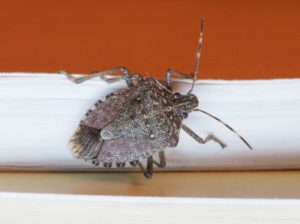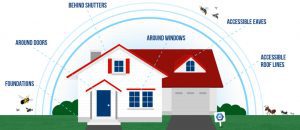“HIBERNATING” BUGS SPENDING THE WINTER IN YOUR HOME?
By Chris Williams on January 10, 2020.
If you’re unlucky enough to be one of those homeowners whose home is regularly invaded by outside insects in the fall, you know what I’m talking about. When the weather gets cooler and the days shorter, certain plant-feeding insects look for places to spend the winter. Whether or not your home is invaded depends on your proximity to the crops and trees that these insects inhabit, and whether your home provides openings that allow the insects inside.
In our region, the western conifer seed bug and the brown marmorated stink bug are two common overwintering insects (see Stink Bugs and Seed Bugs in New England). Certain “Queen” wasps that are destined to start next year’s colonies also often end up spending the winter in homes (see I’ve Got Wasps Inside in February!).
HERE’S HOW THOSE INVADERS GOT INSIDE
Before they hunker down for the winter, these insects often gather on the exterior walls of houses or around the foundation. Many of them then climb up to the roofline and enter around rotting soffits and fascia, gaps around chimneys, or unscreened vents. Others, though, will find openings at ground level where basement doors are missing thresholds and weather-stripping, windows fit loosely or have torn screens, foundation vents are unscreened, or there are gaps around utility conduits where they enter the structure.
You might have noticed some insects wandering around inside in the fall and assumed they wandered back outside. Maybe not. Once inside, the bugs look for a quiet crack or crevice, maybe behind baseboards or draperies, under carpet edging, in wall or ceiling voids. Some homes can have hundreds of insects spending the winter in a wall void or in the attic with the occupants totally unaware. These uninvited guests might wander back outside again in the spring, with no one the wiser.
SOMETIMES OVERWINTERING INSECTS BECOME ACTIVE

Brown Marmorated Stink Bug. Shutterstock.
More often, however, these normally quiet insects may make a brief appearance on unusually warm days in the winter. The change in temperature and copious sunlight on a warm wall might fool the overwintering insects into thinking that it’s spring and time to get a move on.
To say that these insects become “active” is an exaggeration because when they wake from their nap (either in winter or spring) they move slowly and sluggishly at first, often heading for windows or lights. They can usually be vacuumed, swatted, or captured and placed outside. But you should know that some of these insects will exude a foul, defensive fluid when threatened that could stain draperies and other fabrics or surfaces.
YOU DON’T HAVE TO PUT UP WITH THIS NEXT YEAR
If you regularly have a problem with overwintering insects in your home in winter or spring, the time to address the problem is in the fall. You should contact a pest control company about treating around the exterior of your home in early fall before the insects start moving inside (see Fall’s Insect Invaders Are Coming Soon!).
A trained pest control technician can point out attracting conditions around the foundation and openings where insects are getting inside, and some companies will provide pest exclusion services to seal those openings. We can do all of that for you at Colonial Pest Control. Give us a call and let us set you up with our annual Preventative Maintenance Program now which will mean no bug worries next season.
